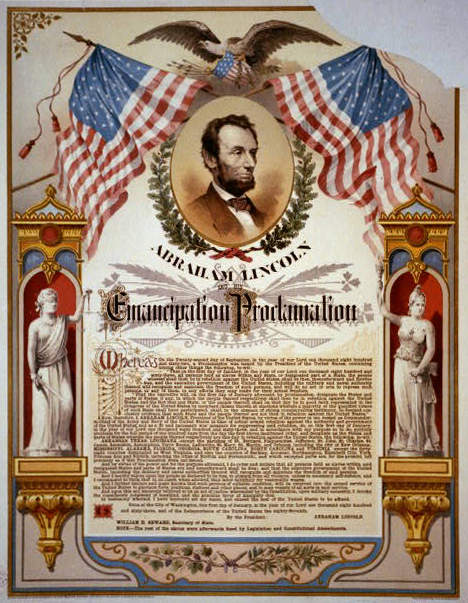

The Emancipation Proclamation
On January 1, 1863, President Abraham Lincoln issued the Emancipation Proclamation. Although, not able to be fully enforced in practice it was seen as symbolic and a strategic war move.
What it did:
- It declared all enslaved people free in the states not loyal to the Union.
- It was a turning point for the war. Up until this point the war had been fought for multiple reasons, it now declared the abolishment of slavery was the primary issue.
- It allowed African Americans to join the military, which was pivotal for the Union’s success.
Its limitations:
- It did not free enslaved people in the border states that had not seceded from the Union.
- The only way to enforce it was to have a Union military presence in that state, which many states did not.
Union states:
California, Connecticut, Illinois, Indiana, Iowa, Kansas, Maine, Massachusetts, Michigan, Minnesota, Nevada, New Hampshire, New Jersey, New York, Ohio, Oregon, Pennsylvania, Rhode Island, Vermont, and Wisconsin
Border States (maintained slavery, but did not secede from the Union):
Delaware, Kentucky, Maryland, Missouri, and West Virginia
Confederate States:
Alabama, Arkansas, Florida, Georgia, Louisiana, North Carolina, Mississippi, South Carolina, Tennessee, Texas, and Virginia
Subscribe!
Get updates on what’s happening here at RAL.
Curriculum Packets
Find the perfect story and the activities to match.
-
 Boo StewDecember 7, 2021/0 Comments
Boo StewDecember 7, 2021/0 Comments -
 WarDecember 7, 2021/
WarDecember 7, 2021/ -
 Indoor Fun Preschool Activity BookDecember 7, 2021/
Indoor Fun Preschool Activity BookDecember 7, 2021/
Tags
activities
activity
african american
african american history
america
american history
black history
black history month
book
book review
books
Christmas
craft
create
culture
diverse books
diversity
famous women
fun
glue
halloween
hard topics
history
inclusivity
juneteenth
kids
learn
learning
math
origin
racism
read
reading
religion
science
slavery
slaves
thanksgiving
tradition
united states
voting
water
women
women in history
Women’s History Month
Categories
- Create
- History Curriculum Reviews
- Learn
- Read
- Black History Month Books
- Book Reviews
- activity book
- asian american and pacific islander
- black history month
- Cancer
- national hispanic heritage month
- Native American Heritage Month
- nurse week
- Picture Books
- Podcasts
- Pride
- Problematic Books
- Science
- Social Studies
- social-emotional learning
- Valentine's Day
- womans history month
- Women's History Month
- young adult
- Christmas Books
- Cinco de Mayo Books
- Halloween Books
- Hanukkah Books
- Juneteenth Books
- Kwanzaa Books
- Thanksgiving Books
- Valentine's Day Books





